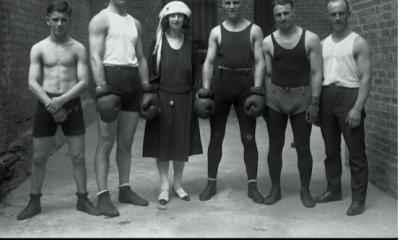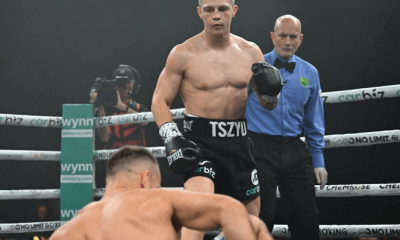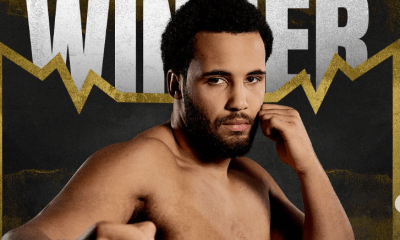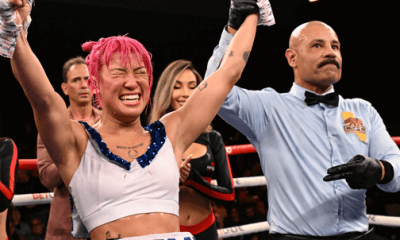Featured Articles
The Hauser Report: USADA, VADA, and the State Athletic Commissions
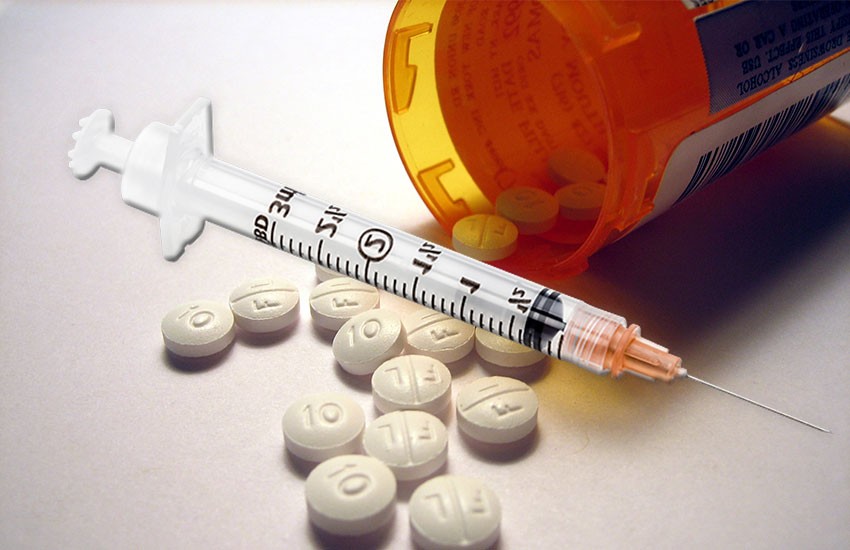
On September 7 of this year, I posted an investigative report on this website entitled “1,501 Tests, One Reported Positive? What’s Going On with USADA and Boxing?”
The article was based on data taken from USADA’s own website in addition to interviews with state athletic commission personnel and experts in the field of performance enhancing drugs. It raised troubling questions regarding the role that USADA plays in boxing today.
USADA has been testing professional boxers for performance enhancing drugs since 2010. As of September 6, 2018, its website stated that it had administered 1,501 tests on 128 professional boxers through August 22 of this year. Yet in all these years, USADA had reported only one adverse finding regarding a professional boxer to a governing state athletic commission.
By way of comparison, Dr. Margaret Goodman (president of the Voluntary Anti-Doping Association, which is widely regarded as the most credible testing organization in professional boxing) reported that close to four percent of the tests for illegal performance enhancing drugs conducted by VADA come back positive. Using the four-percent benchmark, one would have expected that 60 of the 1,501 tests conducted by USADA would have yielded a positive result.
Virtually all of USADA’s tests were administered in conjunction with fights in which companies controlled by Al Haymon had a vested financial interest. The most common venues for the fights in question were Nevada, California, and New York.
What has happened since then?
First, USADA has now conceded to multiple third parties (who request that their names not be mentioned in this article) that there was more than one positive test result but that USADA chose to adjudicate these matters internally without reporting the positive test result to the opposing fighter’s camp or state athletic commission that had oversight responsibility with regard to a given fight.
This is consistent with many of USADA’s contracts, which purport to allow it to adjudicate positive test results without notice to persons and entities with a legitimate interest in the outcome of these tests. However, it runs contrary to the rule in many states that, in the event of a positive drug test, judgments regarding mitigating circumstances must be left to the governing state athletic commission.
As recently as November 23 of this year, Bob Bennett (executive director of the Nevada State Athletic Commission) stated unequivocally that the NSAC must be notified of any adverse findings related to PED tests in and out of competition and that the NSAC has jurisdiction over all adverse findings for PED’s.
It should also be noted that it appears as though every positive test result adjudicated internally by USADA with regard to a professional boxer was adjudicated in favor of the boxer, since there have been no reported adverse findings other than the acknowledgement, after the news leaked on the internet, that Erik Morales tested positive for clenbutereol in 2012.
Second, and equally significant, it appears as though USADA – for the time being at least – has stopped testing professional boxers for performance enhancing drugs.
According to postings on the USADA website (updated through December 7), the most recent tests conducted on professional boxers by USADA were administered to Danny Garcia and Shawn Porter, who fought each other at Barclay’s Center on September 8, one day after this writer’s investigative report was posted.
In other words, a company that tested more than fifteen hundred professional boxers over the course of eight years appears to have suddenly stopped testing professional boxers.
In recent years, USADA has charged in excess of $30,000 for drug testing for each fight. The amount was $150,000 for Floyd Mayweather vs. Manny Pacquiao. Multiply these numbers by more than 1,500 tests and it’s a lot of money to walk away from. Did USADA decide that the spotlight was getting too bright?
The Voluntary Anti-Doping Association (VADA) doesn’t catch all of boxing’s drug cheats any more than the Internal Revenue Service catches all tax cheats. But it catches some of them.
On September 20, 2018, it was announced that a test for performance enhancing drugs conducted on Manuel Charr by VADA had come back positive for epitrenbolone and drostanolone (banned anabolic steroids).
On September 27, it was revealed that a test administered to Billy Joe Saunders by VADA had come back positive for oxilofrine (a banned stimulant).
In other words, VADA reported more positive tests for banned PEDs to supervising state athletic commissions in eight days than USADA has reported in eight years.
Given the fact that USADA charges roughly twice the amount for PED testing that VADA charges, one might ask why anyone in professional boxing would test with USADA. Unless a “get-out-of-jail-free” card comes with the test results.
Andy Foster is executive officer of the California State Athletic Commission. In recent years, he has evinced an admirable commitment to the health and safety of fighters and the integrity of boxing.
Multiple sources say that Foster has made it clear to promoters that he is uncomfortable with the pattern of USADA’s reported test results for boxing and would prefer that promoters use VADA or another reliable testing agency until the issue is resolved. On December 5, Foster told this writer, “It’s the weirdest thing. USADA has reported lots of positive test results for MMA but none for boxing. When it comes to boxing, I feel much more comfortable with VADA.”
The recent PED controversy involving Canelo Alvarez is also instructive.
Alvarez was scheduled to fight a lucrative rematch against Gennady Golovkin in Las Vegas on May 5, 2018. But on March 5, it was revealed that urine samples taken from Canelo by VADA on February 17 and February 20 had tested positive for clenbuterol. Alvarez said that the positive tests were the result of his having inadvertently eaten contaminated meat. But the Golovkin camp refused to let the matter rest and pressed the issue with the Nevada State Athletic Commission.
A March 15 letter sent on behalf of Golovkin to the NSAC and VADA demanded that the commission hold Alvarez to a standard of strict liability insofar as the presence of clenbuterol in his system was concerned. The letter also asked that the NSAC conduct an investigation and hold a full hearing with regard to possible performance enhancing drug use by Canelo.
On March 20, Golovkin raised the ante further when he met with reporters and declared, “I’m a clean athlete. After the first fight, I knew he was not clean. It’s not Mexican meat. Canelo is cheating. They’re using these drugs and everybody is just trying to pretend it’s not happening.”
On March 23, the Nevada State Athletic Commission announced that Alvarez had been temporarily suspended as a consequence of the two positive tests and that the matter would be finally adjudicated at an April 10 commission meeting. On April 3, Canelo announced that he was withdrawing from the fight. Then, on April 18, the NSAC voted unanimously to approve a settlement agreed to by Alvarez that called for Canelo to be suspended for six months retroactive to the date (February 17) of his first positive test for clenbuterol. There was no admission of wrongdoing on Canelo’s part. But there was an acknowledgement that clenbuterol had been present in his system.
On May 15, Alvarez signed up for a full year of VADA testing and paid the $50,000 cost out of his own pocket. His rematch against Golovkin was rescheduled for September 15 and Canelo emerged with a majority-decision triumph.
So let’s look at what happened. A positive test result was properly reported. There was a sanction. Alvarez then came back, tested clean twenty times in an enhanced VADA program, and beat Golovkin.
Now suppose hypothetically that Alvarez had been tested by USADA, not VADA. Suppose USADA advised the Canelo camp of his positive test for clenbuterol and was told, “Canelo says he never used clenbuterol. It must have come from contaminated beef.” And suppose further that USADA said, “That sounds like a reasonable explanation. We’ll adjudicate this internally and give the fighter an inadvertent use waiver. There’s no need to report it to the Golovkin camp and Nevada State Athletic Commission and bring the fight down.”
That would have avoided interfering with a major promotion. But it would also have overlooked the presence of an illegal performance enhancing drug in a fighter’s system.
Unfortunately, some jurisdictions still don’t understand the implications inherent in the use of illegal performance enhancing drugs. Others would rather pay lip service to the issue than deal forcefully with it. And there are significant loopholes in some testing protocols.
Jermall Charlo and Jermell Charlo are two of the most talented fighters in boxing today. Jermall is the World Boxing Council “interim” middleweight champion. Jermell holds the WBC 154-pound belt. As such, the Charlos are subject to the World Boxing Council Clean Boxing Program which requires them to keep VADA apprised of their whereabouts, be reachable by telephone at all times, and be subject to spot testing for performance enhancing drugs at any time.
On November 1, 2018, VADA collection officers went to pick up blood and urine samples from Jermall and Jermell Charlo at their respective homes and were told that neither brother was at home nor would they be at the gym that day. Neither brother picked up his phone at the contact number given to VADA when he was called. And no one could (or would) tell the collection officers where Jermall and Jermell Charlo were.
This is known in drug-testing as a “missed test” or “unsuccessful collection attempt.”
As per the terms of the World Boxing Council Clean Boxing Program, VADA immediately notified the WBC, the Association of Boxing Commissions, and Al Haymon (who represents the Charlos). Because the Charlos are scheduled to fight in separate bouts at Barclays Center in Brooklyn on December 22, VADA also notified Kim Sumbler (executive director of the New York State Athletic Commission) Nitin Sethi (the commission’s chief medical officer), and Tom Brown (who is promoting the December 22 fights).
The WBC Clean Boxing Program is an important initiative. The sanctioning body deserves credit for setting up a PED-testing program with protocols pursuant to which missed tests and positive test results are reported to the governing state athletic commission and other appropriate parties. But the WBC program allows for two missed tests within a one-year period without the imposition of a significant penalty (such as a fighter being stripped of his title).
On November 28, the WBC issued a statement that read in part, “Every single fighter who is enrolled in the WBC Clean Boxing Program is responsible for his acts. It is important for the WBC to clarify that both Charlos have been tested in the past and that the infraction they are facing is a missed test which has been acknowledged and they will be responsible to pay the corresponding fine. It is very simple. If you are chosen for testing and are not available for the collector to test you, you will be incurring a missed test penalty. It is of extreme importance that every fighter updates their whereabouts forms with VADA at all times.”
The WBC declined to reveal the amount of the fine imposed on the Charlos. But in a November 29 email, Alberto Leon (chief legal counsel for the WBC) advised, “In general, for a first whereabouts failure, the fine is limited to the actual costs of collection incurred which so far have fluctuated between $750 and $950 depending on the location of the collection effort.”
In today’s world of microdosing, many illegal PEDs leave an athlete’s system within twenty-four hours. The unfortunate message sent by the WBC regarding the Charlos is, hypothetically speaking, if a fighter takes an illegal performance enhancing drug and, by chance, VADA shows up to test him while the drug is still in his system, the fighter can simply “miss” his test and pay a small fine.
But the matter didn’t end there. On November 27, Jermall Charlo tweeted, “Missed the Test not Failed you idiots. It’s Random and wbc program or Whoever they are Randomly chose a day we were out of town doing promotional stuff on Fox for the Next fight. Get ya facts straight. I like I said Haters must Hate it’s the job.”
As previously noted, the Charlos are scheduled to fight at Barclays Center on December 22. The New York State Athletic Commission acknowledges having been advised of the missed tests but initially maintained in a November 30 email that “The VADA and WADA [World Anti-Doping Agency] programs are separate from the New York State Athletic Commission’s Rules & Regulations.”
In other words, according to the New York State Athletic Commission, the missed tests were a matter for the WBC, not the NYSAC, to resolve. That was a ludicrous position and, three days later, the commission backtracked, saying, “The NYSAC is indeed investigating this matter fully and takes it very seriously. We are undertaking specific actions as part of this investigation and are in regular contact with the promoter, the combatants involved, and their seconds.”
These “specific actions” are said to include additional tests administered to the Charlos at the direction of the NYSAC. That’s a case of too little too late given the transitory nature of performance enhancing drugs in a fighter’s system.
The NYSAC should have acted on the Charlos’ situation in early November. Then, if it felt that a remedy similar to Nevada’s handling of Canelo Alvarez was warranted, the December 22 fight card could have been reconfigured. At this late date, no one expects the NYSAC to interfere with the card.
But let’s follow up with a few questions in response to Jermall Charlo’s tweet. Questions that the New York State Athletic Commission should ask at a hearing with Jermall and Jermell Charlo under oath.
Where were the Charlos doing their out-of-town promotional work for Fox? Presumably, there’s a record of their travel. What, specifically, was the promotional work? Who did they meet with? Why didn’t they answer their phones when the VADA collection officers attempted to reach them? VADA could have sent collection officers to collect blood and urine samples in whatever city the Charlos were in. Jermall and Jermell Charlo might be totally innocent of any wrongdoing. But suppose it turns out that they weren’t out of town that day? That would be a problem, wouldn’t it?”
Meanwhile, after Jarrett Hurd knocked out Jason Welborn on the undercard of Deontay Wilder vs. Tyson Fury at Staples Center on December 1, Jermell Charlo climbed into the ring to challenge Hurd. The two men jawed back and forth with Hurd saying, “Answer the phone. I got the date.”
“My phone is always on,” Charlo responded.
Except when a VADA collection officer calls.
As noted earlier, virtually all of the tests that USADA has administered with regard to professional boxing have been in conjunction with fights in which companies controlled by Al Haymon had a vested financial interest. Haymon is known for looking after his fighters’ best financial interests. But he has a fiduciary duty to all of the fighters he represents, not just the A-side fighters. This fiduciary duty should include taking all reasonable steps to ensure that none of his fighters are put in the ring to face opponents who have increased their punching power through the use of illegal performance enhancing drugs.
Like the Charlos, Errol Spence is an Al Haymon fighter. He’s also deservedly near the top of most pound-for-pound lists.
According to postings on the USADA website, Errol Spence has been tested 35 times by USADA. Did any of these tests come back positive? Were there any “missed” tests? Did USADA ever give Spence a therapeutic use exemption or inadvertent use waiver?
One person who’d like to know the answer to these questions is Victor Conte.
Conte was first known to sports fans as the mastermind behind the BALCO scandal. In recent years, he has been a positive force for education and reform and now works with athletes as a conditioner and nutritionist at a facility in San Carlos, California, known as SNAC (an acronym for Scientific Nutrition for Advanced Conditioning).
In late-October, Conte agreed to help Mikey Garcia prepare for a scheduled March 16, 2019, fight against Errol Spence. But he made it a precondition to his involvement that both Garcia and Spence enroll in VADA.
“So far,” Conte says, “Mikey has been willing to enroll, and Errol has been dragging his feet. Now I’m told that Errol and Al Haymon will agree to ten weeks of testing starting on January 5th. Ten weeks of VADA testing is better than none. But why the wait?”
“It’s common knowledge,” Conte continues, “that the benefit an athlete retains from using certain performance enhancing drugs carries over for months. In fact, you don’t perform at your best when you’re actually on the drugs. You get maximum benefit after the use stops. It all depends on what an athlete was taking, how much he was taking, how long he was taking, and when he cycled off. So my question is, ‘If Errol Spence and Al Haymon aren’t hiding anything, why couldn’t VADA testing have started in November?'”
“And there’s another point I’d like to make about Errol,” Conte continues. “When a person uses testosterone, part of it converts to dihydrotestosterone and the rest converts to estrogen. And when that happens, it can cause the tissue around the nipples to swell. Technically, the condition is called gynecomastia. Some people who use testosterone get gynecomastia. Others don’t. It depends on one’s genetic disposition. Body-builders treat the condition by using Tamoxifen or Arimidex to shrink the tissue.”
And what does that have to do with Spence?
“I was in Las Vegas on September 15 and went to something called the Boxing Fan Expo,” Conte answers. “Errol was there. I got within a few feet of him. He was wearing a white shirt, and I saw what I believe were signs of gynecomastia. If you’ve seen a fighter in the past without gynecomastia and then you see him with it, it causes suspicion. Errol is a hell of a fighter. I have no reason to not like him and I’m not saying that Errol is using anything inappropriate. But I’m suspicious, and Errol knows it.”
At present, many state athletic commissions are reluctant to push hard on the issue of performance enhancing drugs because they fear that doing so will lead promoters to take big fights to other jurisdictions. But illegal PED use is analogous to fighting with loaded gloves. In each instance, the aim is to gain a competitive advantage and inflict more physical damage on an opponent by cheating. Everyone in boxing who lets this issue slide is complicit.
It’s ridiculous to think that Margaret Goodman and VADA can put a thumb in the dike and stop the flow of illegal performance enhancing drugs in boxing. Accomplishing this end will take a concerted effort by state athletic commission officials, sanctioning body officials, promoters, managers, fighters, members of the media, and law enforcement authorities.
Meanwhile, as an interim step, the New York, California, and Nevada state athletic commissions should ask USADA for the following:
(1) Copies of all contracts entered into by USADA for the testing of any professional boxer in conjunction with any fight that has taken place in their jurisdiction since January 1, 2016.
(2) Copies of all test results (complete test results, not just summaries) and all other documents that embody the results of tests conducted pursuant to these contracts.
(3) Copies of all documents that relate to instances, if any, where USADA, pursuant to these contracts, adjudicated issues that arose in conjunction with a positive test for one or more substances that are prohibited under the WADA code.
(4) Copies of all documents that relate to any instance where, pursuant to these contracts, USADA departed from World Anti-Doping Agency standards in adjusting the permissible level of any drug that might be found, or was found, in a professional boxer.
To help evaluate this data, USADA should also be asked with regard to all fights that have taken place in each respective state since January 1, 2016:
(1) On how many occasions has the “A” sample of a professional boxer tested by USADA come back positive for a substance that is prohibited under the WADA code?
(2) On how many occasions has a professional boxer “missed” a test?
USADA is skating on thin ice when it comes to boxing. An exploration of its conduct here might provide a window onto its testing of other athletes. For example, United States Olympic athletes.
If a government entity with subpoena power decides to seriously investigate, the implications could extend far beyond boxing. Maybe USADA will test clean. Maybe not.
Thomas Hauser can be reached by email at thauser@rcn.com. His next book – Protect Yourself At All Times – was published by the University of Arkansas Press this past autumn. In 2004, the Boxing Writers Association of America honored Hauser with the Nat Fleischer Award for career excellence in boxing journalism.
Check out more boxing news on video at The Boxing Channel
To comment on this article at The Fight Forum, CLICK HERE
-

 Featured Articles4 weeks ago
Featured Articles4 weeks agoThe Hauser Report: Zayas-Garcia, Pacquiao, Usyk, and the NYSAC
-

 Featured Articles3 weeks ago
Featured Articles3 weeks agoOscar Duarte and Regis Prograis Prevail on an Action-Packed Fight Card in Chicago
-

 Featured Articles2 weeks ago
Featured Articles2 weeks agoThe Hauser Report: Cinematic and Literary Notes
-

 Book Review2 weeks ago
Book Review2 weeks agoMark Kriegel’s New Book About Mike Tyson is a Must-Read
-

 Featured Articles4 weeks ago
Featured Articles4 weeks agoRemembering Dwight Muhammad Qawi (1953-2025) and his Triumphant Return to Prison
-
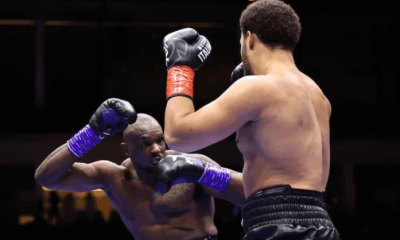
 Featured Articles7 days ago
Featured Articles7 days agoMoses Itauma Continues his Rapid Rise; Steamrolls Dillian Whyte in Riyadh
-
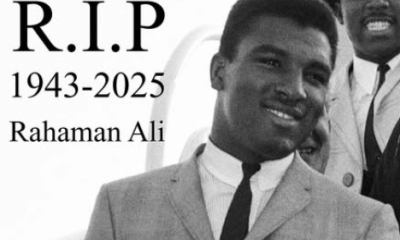
 Featured Articles3 weeks ago
Featured Articles3 weeks agoRahaman Ali (1943-2025)
-

 Featured Articles3 weeks ago
Featured Articles3 weeks agoTop Rank Boxing is in Limbo, but that Hasn’t Benched Robert Garcia’s Up-and-Comers




